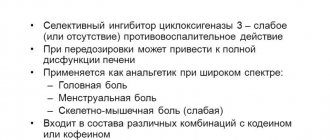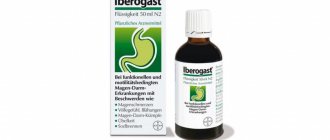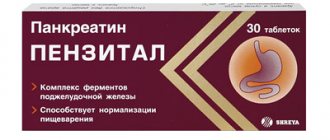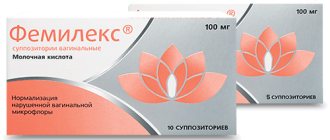Allergies are a fairly common problem. Sneezing, itching, inability to enjoy nature, animals and much more... It affects the general condition of a person, irritability, fatigue, and bad mood appear.
But now the pharmaceutical industry makes it possible to successfully combat the disease. Now allergy symptoms can be eliminated with the help of medications, one of which is Cetrin.
Allergy medications
Pharmacological properties
Pharmacodynamics
A competitive histamine antagonist, a metabolite of hydroxyzine, blocks histamine H1 receptors. Prevents the development and facilitates the course of allergic reactions, has antipruritic and antiexudative effects. Affects the early stage of allergic reactions, limits the release of inflammatory mediators at the “late” stage of the allergic reaction, reduces the migration of eosinophils, neutrophils and basophils. Reduces capillary permeability, prevents the development of tissue edema, relieves spasm of smooth muscles.
Eliminates skin reactions to the introduction of histamine, specific allergens, as well as to cooling (with cold urticaria). Reduces histamine-induced bronchoconstriction in mild bronchial asthma.
It has virtually no anticholinergic and antiserotonin effects.
In therapeutic doses it practically does not cause a sedative effect. The onset of the effect after a single dose of 10 mg of cetirizine is 20 minutes, lasts more than 24 hours. During the course of treatment, tolerance to the antihistamine effect of cetirizine does not develop. After stopping treatment, the effect lasts up to 3 days.
Pharmacokinetics
Rapidly absorbed from the gastrointestinal tract, the time to reach maximum concentration (TCmax) after oral administration is about 1 hour. Food does not affect the completeness of absorption (AUC), but prolongs TCmax by 1 hour and reduces the maximum concentration (Cmax) by 23% . When taken at a dose of 10 mg once a day for 10 days, the equilibrium concentration of the drug (Css) in plasma is 310 ng/ml and is observed 0.5–1.5 hours after administration. Plasma protein binding is 93% and does not change with cetirizine concentrations in the range of 25–1000 ng/ml. The pharmacokinetic parameters of cetirizine change linearly when administered at a dose of 5–60 mg. Volume of distribution – 0.5 l/kg.
In small quantities, it is metabolized in the liver by O-dealkylation to form a pharmacologically inactive metabolite (unlike other H1-histamine receptor blockers, which are metabolized in the liver with the participation of the cytochrome P450 system). Cetirizine does not accumulate. About 2/3 of the drug is excreted unchanged by the kidneys and about 10% in the feces.
Systemic clearance – 53 ml/min. The half-life (T1/2) in adults is 10 hours, in children 6–12 years old – 6 hours, 2–6 years old – 5 hours, 0.5–2 years old – 3.1 hours. In elderly patients, T1/2 increases by 50%, systemic clearance is reduced by 40% (decreased renal function).
In patients with impaired renal function (creatinine clearance below 40 ml/min), drug clearance decreases and T1/2 lengthens (for example, in patients on hemodialysis, the total clearance decreases by 70% and is 0.3 ml/min/kg , and T1/2 is extended by 3 times), which requires a corresponding change in the dosage regimen. It is practically not removed during hemodialysis.
In patients with chronic liver diseases (hepatocellular, cholestatic or biliary cirrhosis), an increase in T1/2 by 50% and a decrease in total clearance by 40% are observed (adjustment of the dosage regimen is required only with a concomitant decrease in glomerular filtration rate). Passes into breast milk.
What generations of antiallergic drugs exist?
First, let's figure out what generations of antihistamines exist. This is important, since the effectiveness of drugs and the ability to influence the central nervous system depend on the generation. The drugs include active substances - histamine receptor blockers. And as you know, histamine is responsible for the appearance of a reaction to an irritant (itching, redness, swelling, rashes), it is he who starts this process.
Today, there is a division of antiallergic drugs into generations. There are only three of them. Cetrin belongs to the second.
- I generation
Suprastin, Tavegil, Diazolin, Fenistil, etc. non-selective in their action on receptors. This means that they affect the central nervous system and gastrointestinal tract. Such indiscriminateness gives rise to a powerful antihistamine effect, but drowsiness appears as a “side effect”.
- II generation
Zyrtec, Zodak, Cetrin, Cetirizine, Parlazine, etc. have less effect on the central nervous system, since they are selective with respect to receptors. Accordingly, drowsiness as an adverse reaction is less pronounced. But with selectivity, the effectiveness of anti-allergy drugs disappears when compared with the first generation.
- III generation
Claritin, Erius, etc. characterized by high selectivity for histamine receptors. Drugs of this generation do not interact with the central nervous system, and such behavior entails the absence of drowsiness as a side reaction of the body. As for the effectiveness against allergies, these drugs are no lower than when compared with the first generation.
Use during pregnancy and breastfeeding
Pregnancy
When analyzing prospective data on pregnancy outcomes, no cases of malformations, embryonic and neonatal toxicity with a clear cause-and-effect relationship were identified.
Animal studies have not revealed any direct or indirect adverse effects of cetirizine on the developing fetus (including in the postnatal period), pregnancy and childbirth.
There have been no controlled clinical studies on the safety of the drug during pregnancy, therefore cetirizine should not be used during pregnancy.
Breast-feeding
Cetirizine is excreted in breast milk in concentrations representing from 25% to 90% of the drug concentration in the blood plasma, depending on the time of administration. During breastfeeding, the drug is used after consultation with a doctor, if the expected benefit to the mother outweighs the potential risk to the child.
Fertility
Available data on the effects on human fertility are limited, but no adverse effects on fertility have been identified.
Benefits of the drug Cetrin
Cetrin is a second generation antiallergic drug. It is recommended to take it as an anti-inflammatory, as well as to prevent exacerbation of the disease.
The drug is based on cetirizine. This active substance prevents the formation of allergy symptoms (itching, swelling, pain, etc.). If you follow the dosage prescribed by your doctor, Cetrin will not cause drowsiness. The lack of sedative effect is due to the inability of cetrizine to penetrate the blood-brain barrier to the structures of the central nervous system.
By stopping itching, Cetrin indirectly prevents the development of skin infections, which often occur after scratching the area where the rash appears, or the itching of the skin is most active. It reduces the allergic response of the skin and bronchi, preventing the so-called atopic march, which is characterized by the evolution of dermatitis into bronchial asthma or rhinitis of an allergic nature.
Allergy
The therapeutic effect of taking Cetrin can be observed after twenty minutes, its duration is about a day. If you stop taking it, its echoes may be observed within three days. The effect will, of course, weaken. Thus, Cetrin:
- eliminates itching;
- relieves and prevents swelling;
- relieves spasm of smooth muscles;
- reduces capillary permeability and fluid release into tissues.
Also, the drug makes allergic rhinitis less painful. It relieves nasal congestion, stops exhausting sneezing, eliminates itching and excessive lacrimation.
In mild forms of bronchial asthma, Cetrin quite significantly reduces the number of attacks during the period of therapeutic treatment or, if there is a doctor’s indication for this, prophylaxis. It is worth noting that Cetrin is also good at relieving urticaria.
Directions for use and doses
Orally, regardless of food intake, without chewing, the tablets are taken with 200 ml of water.
Adults – 10 mg (1 tablet) 1 time a day or 5 mg (1/2 tablet) 2 times a day.
Children over 6 years old – 5 mg (1/2 tablet) 2 times a day or 10 mg (1 tablet) 1 time a day.
In patients with reduced renal function (creatinine clearance 30–49 ml/min), 5 mg/day (1/2 tablet) is prescribed, in severe chronic renal failure (creatinine clearance 10–30 ml/min) – 5 mg/day ( 1/2 tablet) every other day.
Analogs
The pharmacological market offers quite a lot of synonyms (contains cetirizine) and analogues (drugs of similar therapeutic action, that is, histamine blockers).
First generation antihistamines are usually cheaper. But, importantly, they are not highly selective and cause adverse reactions from the central nervous system. Analogues that are part of the third generation act selectively, do not affect the nervous system, but are more expensive.
Analogs
Synonyms: Cetirizine, Zyrtec, Zodak, Parlazin.
Analogues: Glencet, Claritin, Xizal, Suprastinex, Tavegil, Loratadine, Erius, Ketotifen, Claridol, Clarotadine.
- Tsetrin/Zodak
The active ingredient of Zodak is cetirizine. We can conclude that there is no difference between them. Cetrin is cheaper than the Czech drug-synonym.
- Tsetrin/Tavegil
The active component of Tavegil is clemastine, a first generation histamine blocker.
Interestingly, drowsiness occurs quite rarely when taking Tavegil. Tavegil in ampoules is used in the treatment of allergies, as well as as a complete remedy for Quincke's edema and anaphylactic shock.
The effect of clemastine lasts for 12 hours, and cetirizine for 24 hours. Taking Cetrin is not accompanied by drowsiness, and, unlike clemastine, it is not metabolized in the body.
Tavegil is well studied, has an injectable dosage form and is cheaper than Cetrin.
- Cetrin/Claritin, Loratadine
The effectiveness of both products is comparable, but Cetrin shows itself better for skin manifestations of allergies.
- Cetrin/Erius
The active ingredient is desloratadine, a third generation histamine blocker. It extremely rarely causes side effects. Therefore, taking Erisu is recommended for long-term therapy. Erius is stronger and more effective than Cetrin.
- Cetrin/Suprastin
The active ingredient is chloropyramine hydrochloride. Suprastin is effective for 3-6 hours. But it has quite a lot of side effects: drowsiness, loss of energy, stool disturbances, dry mucous membranes, nausea, vomiting, increased eye pressure. Suprastin should not be used in children under 3 years of age. Moreover, it cannot be used as a prevention against allergies. The effectiveness of Cetrin is slightly higher. It causes virtually no side effects, especially drowsiness.
Manifestations and symptoms of allergies in children:
- Diathesis, atopic dermatitis. Accompanied by rashes.
- Hay fever. When pollen gets on the nasal mucosa, inflammation begins. The child sneezes, has difficulty breathing, and has nasal discharge.
- Allergic conjunctivitis. There is swelling of the eyelids and profuse lacrimation. Itching, photophobia, and a feeling of “sand” in the eyes may occur.
- Hives. Accompanies food and contact allergies. Skin rashes resemble mosquito bites or a nettle sting.
- Bronchial asthma is a particularly severe manifestation of allergies. Epidemiological studies in recent years confirm the high prevalence of asthma among children. It becomes difficult for the child to breathe, whistling and wheezing are heard, a debilitating cough appears, and attacks of suffocation are typical. The child gets tired quickly and has difficulty concentrating, complaining of drowsiness[4].
In a single manifestation, most symptoms do not pose a strong threat (with the exception of asthma attacks, Quincke's edema). It is enough to take the appropriate medicine. But it is necessary to take into account that reactions will appear constantly. General health may worsen each time. Over time, a negative reaction to the drug used in treatment occurs.
Allergies must be treated, but not every medicine is suitable for a child.
How to take Cetrin®:
- Regardless of food intake.
- Take one tablet (10 mg) per day or 0.5 tablets (5 mg) twice a day with plenty of water.
- 3. If a side effect occurs, discontinue the drug.
Another reason for the popularity of the drug Cetrin® among parents is the low risk of side effects. The drug is a 2nd generation antihistamine and is well tolerated by children. Only in isolated cases may reactions occur from the central nervous system (drowsiness, dizziness, etc.), gastrointestinal tract (discomfort, dry mouth), allergic manifestations (rash, urticaria, itching, etc.).
For more detailed information about contraindications and side effects, please refer to the instructions for medical use.
Bibliography:
[1] Pariyskaya T.V. Allergy. Mom, I want to be healthy! / T. V. Pariyskaya. – M.: Eksmo, 2009. – 95 p.
[2] Dranik G.N., Clinical allergology and immunology: a manual for doctors / G.N. Dranik. – M.: Publishing house Medical Information Agency, 2003. – 604 p.
[3] Patterson R., Allergic diseases: diagnosis and treatment. / R. Patterson, L. K. Grammer, P. A. Greenberg; edited by A. G. Chuchalina. - M.: GEOTAR MEDICINE, 2000. - 768 p.
[4] National program “Bronchial asthma in children. Treatment strategy and prevention” / ed. ed. A. G. Chuchalina. – 3rd ed., revised. and additional - M.: Publishing House Atmosphere, 2008. - 108 p.
[5] Federal clinical recommendations for the diagnosis of allergic diseases // Russian organization of allergists and clinical immunologists (RAACI). – Moscow, 2015. – 9-12 p.
[6] Instructions for use of the medicinal product for medical use Cetrin®. – Registration number: P N013283/01.
[7] Cetrin® [Electronic resource] / Access mode: https://grls.rosminzdrav.ru / (Last access date 11/09/2017).
Contraindications and adverse reactions, signs of overdose
The drug should not be taken if the components are intolerant, during pregnancy and breastfeeding. Relative contraindications are old age, chronic renal failure. For such patients, the dosage is selected individually.
The syrup is not intended for the treatment of children under 2 years of age; tablets are prescribed from 6 years of age.
The drug rarely causes significant side effects. Most often, patients complain of increased thirst and drowsiness. Migraines and headaches, discomfort in the abdomen, increased allergic reactions, and attacks of dizziness are rarely observed.
In case of an overdose, disturbances in the functioning of the nervous system occur. When the recommended dose is increased by 5 times, drowsiness, tremor, increased heart rate, and urinary retention occur. First aid rules - induce vomiting, perform gastric lavage, take a laxative and enterosorbent. It is necessary to call a doctor and examine the functions of the respiratory and cardiovascular systems.
Side effects
Side effects when taking antihistamines do not occur often. Drowsiness and a feeling of dry mouth may occur. Less commonly noted:
- Severe headaches.
- Dizziness.
- Dyspeptic disorders.
- Migraine.
- Allergic reactions - itching, swelling, hyperemia, skin rashes. In severe cases, urticaria and angioedema develop.
Composition and description of the drug
The active substance of the drug Cetrin is cetirizine hydrochloride. It is a metabolite of hydroxyzine, a blocker of H1 histamine receptors, and a histamine antagonist.
Release form:
- Round white coated tablets, each containing 10 mg of active substance. There is a dividing strip on one side. There are 20 or 30 tablets in a package.
- Syrup is a clear, colorless liquid with a fruit aroma. The concentration of the active substance is 1 mg per 1 ml. Available in dark glass bottles, volume 30 or 60 ml.
Store the medicine in a dark place at a temperature of 20-25 degrees. Shelf life – 36 months.





